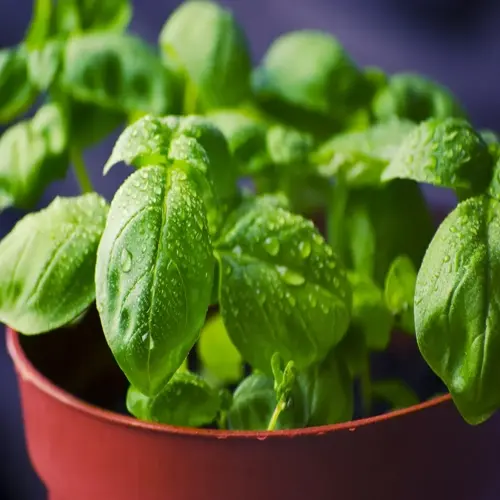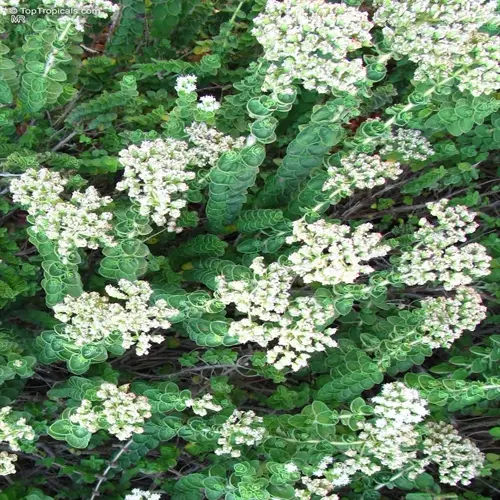How to Grow Parsley: Complete Expert Guide

Written by
Liu Xiaohui
Reviewed by
Prof. Martin Thorne, Ph.D.Learn how to cultivate parsley by understanding proper seed soaking and indoor timing methods.
Select flat-leaf Italian parsley for cooking or curly types for garnish.
Select soil temperatures of 60-70 degrees Fahrenheit and well-draining soil for optimal growth.
Cut outer stems first with scissors to promote continued growth.
Deal with yellow leaves with fish emulsion fertilizer high in nitrogen every two weeks.
Keep roots in moistened sand stored at 32-40 degrees Fahrenheit for a couple of months.
Article Navigation
Understanding how to grow parsley transforms your parsley from a garnish into an herb garden keeper. I have grown it on windowsills, porches, and balconies as an urban gardener. This herb has considerably more vitamin C than oranges. Plus, you'll enjoy fresh flavor for meals year-round.
Parsley is a great option for tight spaces because it only needs about six inches of soil depth. My apartment garden demonstrates that you don't need a backyard. Its tight growing habit makes it ideal for container gardening. You can harvest from just one pot numerous times.
This resource discusses everything from soaking seeds to harvesting in the winter. We discuss ways to set up indoor and outdoor beds. You will learn correct protocols for all environments. Planning for germination challenges is detailed.
Parsley Varieties Explained
Selecting the proper type of parsley enhances your gardening skills and cooking abilities. Flat-leafed Italian parsley provides strong flavor and peppery notes appropriate for sauces and stews. It maintains its flavor while cooking. Curly parsley offers a softer freshness that complements garnish or salads and salad dressings.
Hamburg parsley has a distinct edible root that is similar in flavor to both celery and parsnip; I will roast this root like a winter vegetable. Hamburg parsley has a taproot that is significantly longer than that of a leaf variety and requires deeper soil. This variety is also better suited for cooler climates.
There is a considerable difference in heat tolerance among the varieties. Flat-leaf parsley tolerates warmer zones better. Curly parsley prefers cooler conditions. In my Texas garden, I prefer flat-leaf for summer harvest. A northern gardener might prefer curly types.
Keep the heights of plants in mind as you plan your garden. Flat-leaf will grow 12-18 inches tall. Curly will be about 8-12 inches tall, remaining more compact. Hamburg is the tallest grower at 24 inches. Remember to give each plant enough space for air to circulate freely around it.
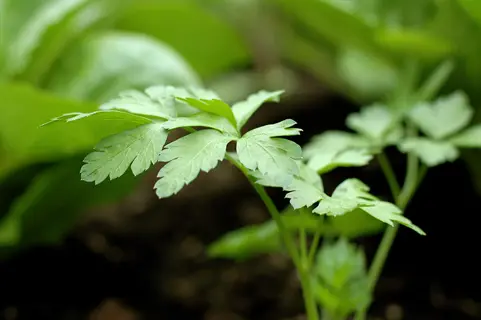
Flat-Leaf Italian Parsley
- Flavor characteristics: This variety offers a robust peppery taste profile with clean herbal notes that significantly enhance Mediterranean dishes and cooked preparations requiring strong herbal presence
- Visual identification: Features distinct dark green flat leaves that closely resemble celery tops with pronounced serrated edges visible throughout the plant structure
- Culinary applications: Essential foundational component in traditional chimichurri sauces, authentic tabbouleh salads, and herb butter preparations where its potent flavor withstands cooking processes effectively
- Growth specifications: Mature plants typically reach substantial heights between 18-24 inches tall with multiple upright stems forming compact clusters ideal for small garden spaces or containers
- Climate adaptation: Demonstrates superior heat tolerance compared to curly varieties during peak summer months in warmer regions where other herbs might struggle or bolt prematurely
- Productivity level: Consistently produces approximately 30% more harvestable leaves than curly types throughout the entire growing season under optimal conditions
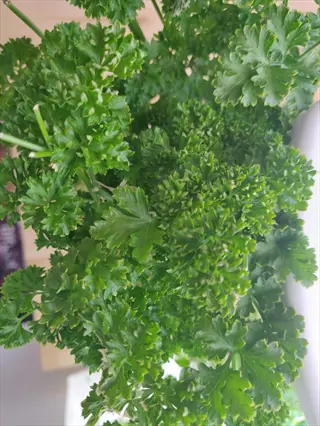
Curly Parsley
- Visual distinction: Displays characteristically tightly ruffled bright green leaves that create beautifully decorative garden borders and elegant plate presentations for restaurant-quality food styling
- Taste profile: Provides noticeably milder flavor with subtle bitterness that complements delicate dishes requiring less herb intensity such as fish preparations and light sauces
- Texture advantage: Maintains structural crispness longer in simmering soups and stews during extended cooking times compared to flat-leaf varieties that soften more quickly
- Companion benefits: Excellent partner plant for rose bushes and tomato beds due to natural pest-repelling properties that protect neighboring plants from common garden insects
- Size parameters: Grows to moderate heights between 8-14 inches tall while forming dense ornamental clumps perfect for container gardening arrangements with limited space
- Preservation quality: Retains vibrant green pigmentation better when frozen or dried than other parsley varieties available on the market today
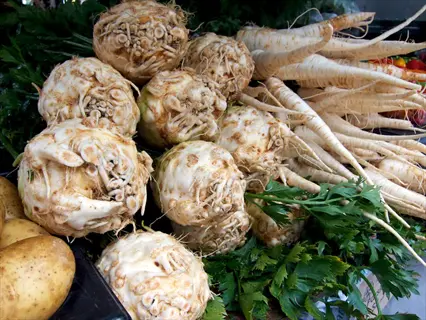
Hamburg Root Parsley
- Unique characteristic: Develops substantial edible white taproots similar in appearance to parsnips but with concentrated parsley flavor throughout the root structure itself
- Harvest requirements: Needs a complete full growing season to produce properly developed 6-8 inch roots suitable for diverse culinary applications and cooking techniques
- Preparation techniques: Roots can be finely shaved raw into fresh salads for crisp texture or slowly roasted like traditional root vegetables to concentrate their natural sugars
- Foliage usage: While less abundant than other varieties, the leaves remain completely usable like standard parsley in cooking when harvested young and tender
- Growth cycle: Strict biennial requiring two complete seasons for proper root development and maturity readiness before becoming suitable for kitchen use
- Storage capacity: Roots preserve exceptionally well for 4-6 months in cool dark conditions using similar storage methods to carrots and other root vegetables
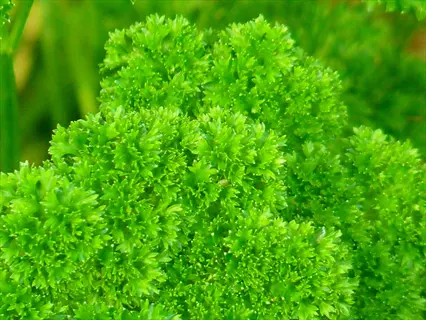
Moss Curled Parsley
- Appearance details: Features distinctively deep green extra-curled leaves with finer texture and tighter formation than standard curly parsley varieties available commercially
- Climate resilience: Tolerates both cool spring temperatures and intense summer heat better than most parsley types making it versatile across diverse growing zones
- Culinary strength: Preferred choice for authentic Middle Eastern dishes including tabbouleh and fattoush where its flavor profile matches traditional recipes perfectly
- Pest management: Naturally repels problematic carrot flies when planted near vulnerable vegetables in garden bed arrangements without chemical interventions
- Growth pattern: Compact 10-12 inch plants ideal for container gardening situations with limited vertical space while still providing substantial harvests
- Flavor retention: Maintains its distinctive taste characteristics better during commercial drying processes compared to other available parsley cultivars
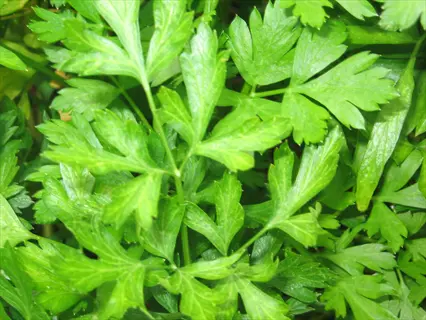
French Broad-Leaf Parsley
- Leaf structure: Produces exceptionally large flat leaves with broader surface area than Italian varieties resulting in higher yield per plant when harvested regularly
- Flavor intensity: Stronger taste profile than standard flat-leaf parsley suitable for hearty stews and long-cooking braises where flavor must persist through preparation
- Growth habit: Taller vertical growth reaching 2-3 feet often requiring staking in windy locations for optimal development and protection from stem damage
- Harvest advantage: Larger individual leaves allow significantly quicker gathering of substantial quantities for cooking needs compared to smaller-leaved varieties
- Culinary use: Ideal for traditional bouquet garni and stocks where robust herb flavor needs infusion without premature disintegration during extended cooking
- Garden placement: Best positioned strategically at rear of herb gardens due to its significant height compared to other parsley varieties
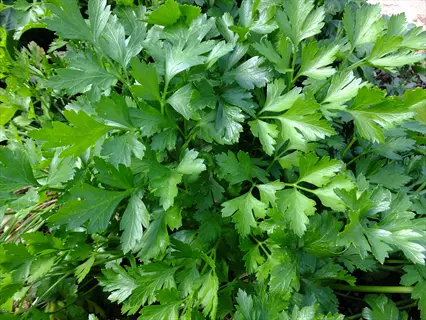
Japanese Parsley
- Botanical distinction: Known botanically as Mitsuba with unique flavor combining parsley, celery and mild cilantro notes unlike any other variety available
- Appearance traits: Features distinctive tri-lobed leaves on slender stems resembling miniature celery plants in overall growth pattern and structure
- Culinary application: Essential in traditional Japanese cuisine for clear soups, sunomono salads and elegant garnishes requiring complex herbal flavor notes
- Light preference: Thrives exceptionally well in partial shade conditions where other parsley varieties might struggle to develop properly or produce weak growth
- Growth cycle: Perennial in warmer hardiness zones but typically grown as annual in temperate climate regions worldwide with distinct seasonal patterns
- Harvest method: Best picked young before flowering occurs for maximum tenderness in stems and leaves with peak flavor concentration present
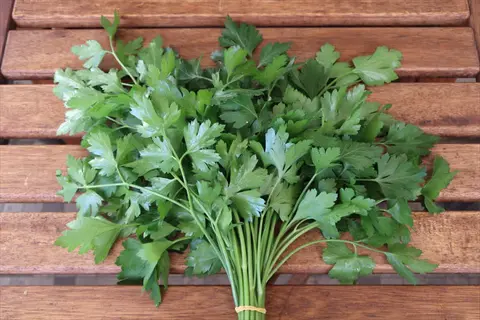
Giant of Italy Parsley
- Size specification: Exceptionally large flat leaves growing up to 3 inches wide on vigorous 24-inch plants that dominate herb garden spaces visually
- Flavor quality: Noticeably milder taste than standard Italian parsley suitable for raw applications and fresh garnishes where subtlety is preferred
- Productivity level: High-yielding variety producing abundant foliage continuously for extended harvesting throughout the entire growing season
- Garden performance: Excellent natural bolting resistance maintains leaf quality longer in warm weather conditions than heat-sensitive varieties
- Culinary versatility: Perfect choice for large-batch pestos and herb pastes where substantial leaf volume is required quickly without multiple harvests
- Storage capacity: Retains texture and color better than most varieties when properly refrigerated in airtight containers for up to two weeks
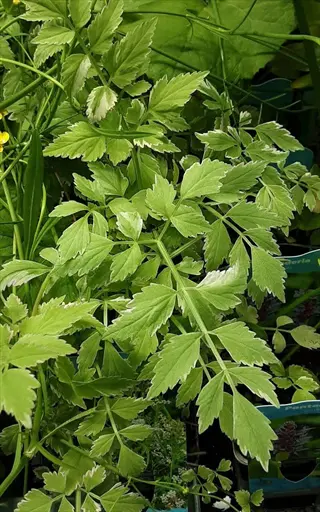
Paramount Parsley
- Disease resistance: Developed through selective breeding specifically for enhanced resistance to leaf spot and other common fungal issues in humid climates
- Leaf structure: Produces extra dark green flat leaves with thick cellular texture holding up remarkably well in extended cooking processes
- Growth uniformity: Exceptionally consistent plant habit ideal for both commercial growers requiring standardization and home gardeners seeking reliability
- Cold tolerance: Withstands light frosts better than most varieties effectively extending the harvest window deep into late autumn months
- Regrowth rate: Quick recovery after cutting allows more frequent harvests than standard parsley cultivars throughout the active growing season
- Garden placement: Suitable for dense planting arrangements at 6-8 inch spacing due to naturally upright non-spreading growth habit
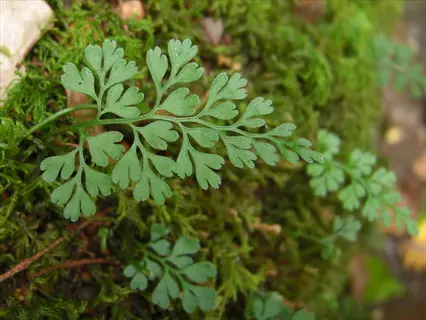
Fern-Leaved Parsley
- Foliage appearance: Delicate feathery leaves resembling fine fern fronds creating unique textural visual interest in ornamental herb gardens
- Flavor profile: Contains more intense concentration of essential oils than standard parsley varieties resulting in potent seasoning characteristics
- Growth pattern: Airy 18-inch plants suitable for interplanting among flowers without creating problematic dense shade for sun-loving companions
- Harvest technique: Best harvested carefully by pinching individual leaf clusters rather than cutting entire stems to preserve plant vitality
- Drying suitability: Maintains maximum aromatic flavor when air-dried slowly using traditional methods compared to other parsley cultivar types
- Container performance: Excellent choice for mixed herb containers due to non-competitive root systems that coexist well with neighboring plants
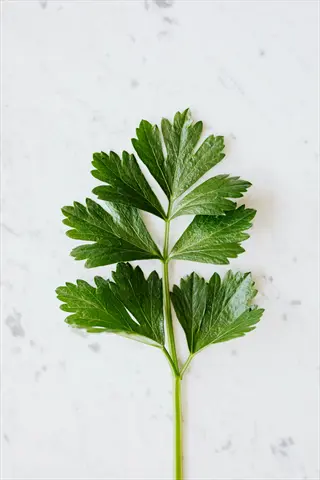
Plain-Leaved Parsley
- Historical significance: Original wild variety from which all modern cultivated parsley types have been selectively developed over centuries
- Leaf structure: Simple flat leaves without serrations containing more intense concentrated flavor than contemporary hybrid varieties available commercially
- Growth habit: Naturally vigorous growth reaching approximately 2 feet tall with tendency to self-seed prolifically in favorable garden conditions
- Cold hardiness: Most frost-tolerant parsley variety surviving temperatures down to 15°F (-9°C) when provided with basic protective mulching
- Biennial nature: Strong reliable second-year seed production ideal for gardeners practicing seed saving and preservation techniques
- Culinary authenticity: Preferred choice by traditional cooks seeking authentic historical flavor in heritage European recipes and preparations
Starting Parsley from Seeds
Due to their hard coats, starting parsley seeds requires a specific technique. Place seeds in 100°F (38°C) water for 12-24 hours before sowing. This simple step softens the seed coat, greatly improving germination. If you don't soak your seeds, germination may take 3 weeks or longer!
Indoor seeding begins 6-8 weeks before your last anticipated frost date. Use seed trays with sterile mix. Outdoor sowing occurs 3-4 weeks before frost, when the soil temperature reaches 50°F. Always use local agricultural extension data to calculate frost dates for more accurate predictions.
To create the perfect seed starting mix, simply combine equal parts peat moss, vermiculite, and perlite. This combination provides the proper drainage and moisture retention. I have found that this ratio effectively prevents damping-off disease, which kills young parsley seedlings.
If germination problems appear, consider two important factors. Seeds require consistently 70°F soil temperatures, typically with the use of heat mats. They need to be planted at a depth of ¼ inch and receive bright light immediately after seeding. Seeds should never be planted too deeply.
Seed Preparation
- Soak seeds in warm water maintained at 100°F (38°C) for 12-24 hours to soften the hard outer seed coat which significantly reduces germination time from 3-6 weeks to 10-14 days
- After soaking, drain seeds thoroughly and spread them on paper towels to remove excess moisture before planting to prevent fungal issues during the germination process
Indoor Starting
- Begin seeds indoors 6-8 weeks before the last expected frost date using seed trays filled with sterile seed-starting mix containing equal parts peat moss, vermiculite, and perlite
- Plant seeds ¼ inch deep maintaining consistent soil temperature of 70°F (21°C) using heat mats and provide 14-16 hours daily under grow lights positioned 2-4 inches above soil surface
Outdoor Sowing
- Direct sow seeds outdoors 3-4 weeks before last frost when soil temperatures reach 50°F (10°C), planting seeds ¼ inch deep in rows spaced 12-18 inches apart
- Cover seeded areas with floating row covers to maintain soil warmth and moisture while protecting emerging seedlings from unexpected late frosts and pest damage
Germination Care
- Maintain consistently moist soil using spray bottles for gentle watering to prevent dislodging seeds, checking moisture twice daily until seedlings emerge in 14-28 days
- Thin seedlings to 9-inch spacing when they develop 2-4 true leaves using scissors to cut weaker plants at soil level to avoid root disturbance
Transplanting
- Harden off indoor-started seedlings over 7-10 days by gradually increasing outdoor exposure before transplanting after last frost when plants reach 3-4 inches tall
- Transplant on overcast days or late afternoons digging holes matching root ball size spacing plants 9-12 inches apart in garden beds with amended soil
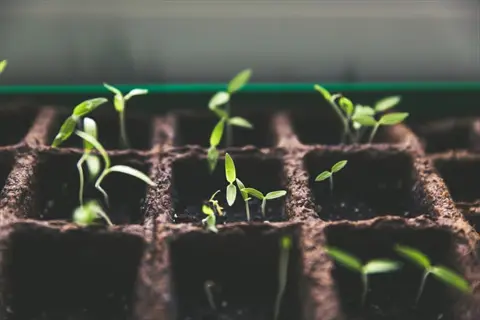
Seed Trays
- Drainage importance: Must have drainage holes to prevent waterlogging which causes seed rot and fungal diseases during critical germination phase
- Cell size recommendation: Use 1.5-2 inch cells to provide adequate root space for parsley's developing taproot system before transplanting
- Material considerations: Recyclable plastic trays offer durability while biodegradable options like cow pots allow direct planting without root disturbance
- Sterilization protocol: Clean trays with 10% bleach solution before reuse to eliminate pathogens that cause damping-off disease in seedlings
- Depth specification: Minimum 3-inch depth required to accommodate parsley's deep root development during early growth stages
- Quantity calculation: Start 30% more seeds than needed to compensate for typical parsley germination rates under home conditions
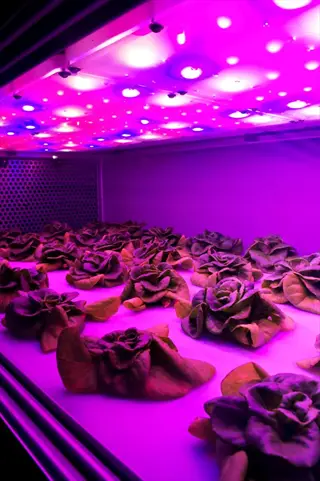
Grow Lights
- Light spectrum: Full-spectrum LEDs providing 400-700nm wavelengths mimic natural sunlight for optimal photosynthesis and compact growth
- Height adjustment: Maintain 2-4 inch distance above seedlings using adjustable chains to prevent leggy growth and light burn
- Duration settings: Programmable timers for 14-16 hours daily light exposure with 8-hour dark periods for proper plant respiration
- Energy efficiency: LED systems consuming 30-50 watts provide adequate illumination while minimizing electricity costs during long germination
- Coverage area: Position lights to evenly cover 2-4 seed trays simultaneously ensuring all seedlings receive uniform light distribution
- Heat management: Low-heat output prevents soil dehydration while maintaining optimal 70-75°F (21-24°C) temperature range for germination
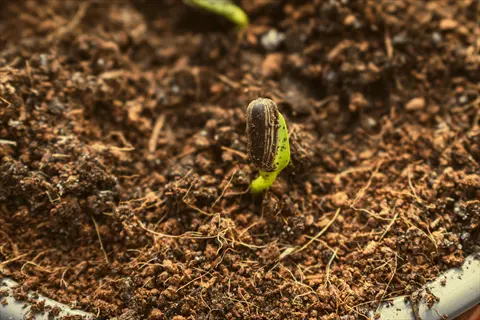
Seed Starting Mix
- Composition ratio: Sterile blend of 1:1:1 peat moss, vermiculite, and perlite ensures proper aeration and moisture retention critical for parsley
- Nutrient profile: Ph-balanced mix with no added fertilizers prevents root burn while providing clean medium for initial growth
- Moisture control: Holds 3-4 times its weight in water while maintaining 30% air space for developing root respiration needs
- Sterility advantage: Pasteurized to eliminate fungal pathogens that cause damping-off disease in vulnerable parsley seedlings
- Texture specification: Fine-particle composition allows small parsley seeds to establish proper soil contact for germination
- Amendments: Add 1 tablespoon lime per gallon to neutralize acidic peat moss creating optimal 5.5-6.7 pH range
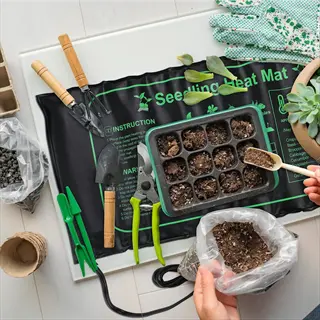
Heat Mats
- Temperature precision: Thermostat-controlled mats maintain consistent 70°F (21°C) soil temperature accelerating germination by 50%
- Size options: Standard 10x20 inch mats fit single seed trays while larger mats accommodate multiple propagation setups
- Safety features: Waterproof construction with automatic shutoff prevents overheating accidents during extended use periods
- Energy usage: Low-wattage designs (15-25W) provide gentle bottom heat without significantly increasing electricity costs
- Placement protocol: Position mats under seed trays with ¼ inch air gap using risers to prevent direct contact and overheating
- Duration guidance: Use continuously until seedlings emerge then gradually reduce heat exposure over 3-5 days
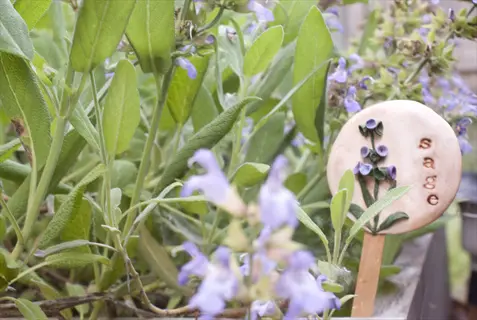
Plant Labels
- Material durability: UV-resistant plastic or metal labels withstand sun exposure without fading throughout long germination period
- Ink specifications: Use waterproof permanent markers rated for outdoor use to prevent information loss from watering
- Information format: Record sowing date, variety name, and expected germination date for accurate progress tracking
- Placement technique: Insert labels at tray edges angled toward center to avoid shading emerging parsley seedlings
- Reusability: Choose smooth-surface labels that clean easily with alcohol wipes for multiple season usage
- Size consideration: 4-6 inch height provides visibility without obstructing light to developing seedlings
Growing Conditions and Care
Get your garden soil ready with particular amendments for parsley victory. Work in 3 inches of composted manure per square foot into the topsoil. Add 40% sand, 40% silt, and 20% clay for proper drainage. This gives the loamy texture that parsley roots enjoy.
Sunlight needs will vary by climate zone. Northern growers (zones 1-6) will need to give 6+ hours of sun exposure to direct sunlight. Southern gardeners (zones 7-11) need morning sun with afternoon shade. My Arizona plants do great with shade cloth protection.
Use a moisture meter to create accurate watering schedules. Probe it to a depth of 3 inches near the roots. Water when the meter dips into the dry zone, which is generally every 3 days in the summer. This will help prevent both dry plant and root rot problems simultaneously.
Fertilize parsley using organic fertilizers according to the different growth stages. Use 5-10-5 NPK upon planting. For established plants, apply liquid 5-1-1 fish emulsion every three weeks. For container parsley, use slow-release 14-14-14 pellets every two months.
Soil Requirements
- Ideal soil composition: Loamy texture with 40% sand, 40% silt, 20% clay for optimal drainage and nutrient retention
- pH range: Maintain 5.5-6.7 acidity; test with digital meter quarterly and amend with lime if below 5.5 or sulfur if above 7.0
- Organic matter: Incorporate 3 inches of composted manure per square foot before planting to boost nitrogen levels
Light Exposure
- Full sun: Minimum 6 hours direct sunlight daily in cooler climates (zones 1-6) for maximum growth
- Partial shade: 4 hours morning sun + afternoon shade in hot regions (zones 7-11) to prevent leaf scorching
- Indoor lighting: Supplement with 5000K LED grow lights at 15W per square foot if natural light is insufficient
Water Management
- Frequency: Water when top 1 inch of soil is dry - typically every 3 days in summer, weekly in winter
- Method: Use drip irrigation or soaker hoses to deliver 1 gallon per plant weekly directly to roots
- Drought response: Parsley survives 2 weeks without water but develops bitter leaves - maintain consistent moisture
Feeding Schedule
- Initial feeding: Apply 5-10-5 NPK fertilizer at planting - 3 oz per 10 sq ft worked into topsoil
- Maintenance: Liquid feed every 3 weeks with fish emulsion (5-1-1) diluted to 1 tbsp per gallon water
- Container plants: Use slow-release pellets (14-14-14) every 60 days - 1 tsp per 6-inch pot
Temperature Range
- Optimal growth: 60-70°F (15-21°C) daytime with 10°F (5°C) nighttime drop for flavor development
- Heat protection: Shade cloth (30%) when temperatures exceed 85°F (29°C) for more than 3 consecutive days
- Cold tolerance: Withstands light frosts down to 28°F (-2°C) - cover with row fabric below this threshold
Harvesting and Storing Parsley
For ongoing production, harvest parsley using the outer-stalk-first method. Cut stalks to a length of 4-6 inches at the soil level using sterilized scissors. Always harvest first thing in the morning for the highest level of essential oils. Never harvest more than a third of the foliage. Immediately follow up with fresh water.
Fresh parsley lasts between 7 and 14 days in the refrigerator if the stems are placed in water. Fermented parsley lasts for 8-12 months. Frozen parsley does dull in color. When freezing, you lose approximately 80% of flavor, while fresh produce maintains about 95%. I prefer to freeze whole sprigs for soups and chopped parsley for sauces.
Dig biennial parsley roots in the fall after the soil is loosened by its first frost. Use gentle pressure with a garden fork, being careful not to bruise the area. Pick roots that are ½-1 inch in diameter and then trim side roots to 1 inch. Treat roots like very delicate carrots to avoid spoilage.
For the best results when freezing parsley, blanch it. Submerge the stems in boiling water for 30 seconds. Immediately place in ice water for an additional 30 seconds. Ensure it is scorched before freezing. Blanching preserves color and texture better than freezing it raw.
Timing and Frequency
- Begin harvesting when plants reach 6 inches tall with at least 3 segments per stem - typically 70-90 days after planting
- Harvest in early morning after dew evaporates when essential oil concentration peaks for maximum flavor retention
- Maintain harvest frequency of 1-2 times weekly during peak season to encourage bushier regrowth
Cutting Method
- Use sterilized scissors to cut outer stems at soil level selecting stems 4-6 inches long with mature leaves
- Never remove more than ⅓ of total foliage at once to avoid stunting growth - leave inner stalks intact
- Cut at 45-degree angle just above growth node to stimulate new branching from the base
Seasonal Adjustments
- Spring/summer: Harvest aggressively every 5-7 days as plants reach peak production phase
- Fall: Reduce harvesting frequency to biweekly allowing plants to store energy for winter
- Winter (indoor plants): Harvest minimally every 2-3 weeks to maintain plant vitality
Biennial Root Harvest
- In second year (fall): Dig roots carefully using garden fork when foliage yellows after first frost
- Select roots ½-1 inch diameter - wash thoroughly and trim side roots to 1 inch length
- Handle gently to prevent bruising which accelerates spoilage during storage
Post-Harvest Plant Care
- Water plants immediately after harvesting to reduce stress and promote rapid regrowth of new stems
- Apply diluted liquid fertilizer (5-1-1 NPK) within 24 hours of heavy harvest to replenish nutrients
- Remove any yellowed or damaged leaves during harvest to maintain plant health and prevent disease spread
Freezing Methods
- Ice cube method: Chop leaves finely pack into trays cover with water/olive oil freeze 24 hours then transfer to bags
- Flash freezing: Spread whole sprigs on baking sheets freeze 2 hours then transfer to airtight containers
- Blanching: Dip stems in boiling water 30 seconds then ice bath before patting dry and freezing
Drying Process
- Air drying: Bundle 5-6 stems hang upside down in dark well-ventilated area for 7-14 days until crisp
- Oven drying: Spread leaves on baking sheets dry at 100°F (38°C) for 2-4 hours with door slightly open
- Dehydrator: Use 95°F (35°C) setting for 4-6 hours until leaves crumble easily between fingers
Root Storage
- Sand method: Layer unwashed roots in boxes with damp sand maintaining 32-40°F (0-4°C) temperature
- Perforated bags: Store in refrigerator crisper with 1-2 holes punched in bags to maintain humidity
- Wax coating: Dip roots in food-grade paraffin wax to seal in moisture before cellar storage
Herb-Infused Oils
- Oil infusion: Pack chopped parsley in sterilized jars cover with olive oil and refrigerate for flavorful dressings
- Shelf life: Use within 2 weeks when refrigerated or freeze in ice cube trays for 6-month storage
- Safety: Add 1 tbsp vinegar per cup to prevent botulism in oil-based preservation methods
Vinegar Preservation
- Preparation: Combine equal parts white vinegar and water add parsley sprigs and refrigerate 48 hours
- Usage: Strain liquid for tangy herb vinegar use solids within 3 days as flavor-packed garnish
- Storage: Keeps 3 months refrigerated in dark glass bottles to preserve color and flavor integrity
Troubleshooting Common Issues
Yellowing parsley leaves typically point to nitrogen deficiency or excessive watering. To remedy this condition, improve it by applying organic fish emulsion fertilizer every two weeks. Always check the soil's moisture level first. If the soil feels saturated, consider improving drainage by adding perlite to the soil. If the plant has root rot, dispose of it and solarize the soil to prevent further growth.
Leggy growth can be a result of inadequate light or overcrowding. Place plants in a brighter area, or use LED grow lights. Thin seedlings to 9-12 inches apart. If the leaves are dark green and the stems are too long, consider reducing the use of nitrogen-based fertilizers.
Leaf curling indicates either aphid activity or exposure to herbicides. Apply a soap solution treatment every three days for two weeks. To protect from suspected chemical drift, rinse leaves immediately. For viral infections, remove infected plants and sterilize tools in a diluted bleach solution.
To deter spider mites, keep temperatures below 85°F. Apply neem oil every five days or five days after pest appearance. Use yellow sticky traps for monitoring whiteflies. Spray unsweetened water and baking soda weekly to manage powdery mildew without harsh chemicals.
Yellowing Leaves
- Nitrogen deficiency: Apply fish emulsion (5-1-1) diluted to 1 tbsp per gallon every 2 weeks until green returns
- Overwatering: Check soil moisture - water only when top inch is dry improve drainage with perlite
- Root rot: Remove affected plants solarize soil at 150°F (65°C) for 4 hours before replanting
Leggy Growth
- Insufficient light: Move outdoor plants to sunnier location provide indoor plants with 5000K LED lights 6 inches above
- Overcrowding: Thin plants to 9-12 inch spacing remove weakest seedlings to reduce competition
- Excess nitrogen: Reduce fertilizer applications test soil and balance with phosphorus-rich amendments
Leaf Curling/Distortion
- Aphid infestation: Spray with soap solution (1 tsp mild soap per quart water) every 3 days for 2 weeks
- Herbicide drift: Rinse leaves immediately with water relocate plants away from treated areas
- Viral infection: Remove affected plants sterilize tools with 10% bleach solution before reuse
White Spots/Powdery Coating
- Powdery mildew: Apply baking soda spray (1 tbsp baking soda + ½ tsp soap per quart water) weekly
- Whiteflies: Use yellow sticky traps introduce ladybugs as natural predators for biological control
- Mineral deposits: Wipe leaves with vinegar solution (1:3 vinegar-water) rinse after 5 minutes
Slow Growth
- Low soil temperature: Use black plastic mulch to warm soil maintain 60-70°F (15-21°C) root zone
- Compact soil: Aerate with garden fork add 30% compost to improve texture and oxygen flow
- Inadequate nutrients: Side-dress with balanced 5-5-5 organic fertilizer at 2 oz per plant monthly
5 Common Myths
Parsley is simply something you put on the plate for decoration with no possible nutritional value
However, parsley has three times the concentration of vitamin C compared to oranges, at 133mg per 100g vs 53mg per 100g for oranges. Parsley also has substantial amounts of vitamin K, offering over 1000% of the recommended daily value per ounce. The herb contains apigenin and other flavonoids that provide strong anti-inflammatory properties, so it is more than just a decorative plate herb, and can stands on its own as an extreme nutrient density food.
All parsley varieties taste exactly the same and therefore can be used interchangeably without any noticeable difference
Flat-leaf Italian parsley offers robust peppery notes ideal for cooked dishes where flavor must persist through heating, while curly parsley has a milder, slightly bitter profile better suited for fresh applications. Hamburg parsley develops carrot-like roots with earthy sweetness completely distinct from leaf varieties. These flavor differences significantly impact recipe outcomes when substituted incorrectly.
Year after year, parsley will come back like a perennial and thrive no matter the climate
Parsley is considered a biennial meaning it has a two-year lifecycle. The first growing season for parsley is focused on developing edible leaves, while the second is on developing flowers and seeds before the plant dies. In certain USDA zones (7-10), parsley can occasionally survive the winter months, however, even there, most gardeners have come to understand that the parsley grown the second year will not taste as good as the first year.
Parsley seeds sprout quickly and easily within just a few days like other herbs
Parsley seeds contain germination inhibitors requiring specific conditions: optimal soil temperatures between 65-75F (18-24C), consistent moisture, and often pre-soaking for 12-24 hours. Natural germination takes 14-28 days due to protective furanocoumarins in the seed coat. This contrasts sharply with basil (5-10 days) or chives (7-14 days), making parsley one of the slowest herbs to germinate.
Parsley needs 24 hours of direct sunlight to grow effectively and does not perform well in shade
Although parsley will do well in partial shade if grown in a cooler climate with 6 hours of direct sunlight during the day, it does perform well in 70 plus degree (F) heat if it gets afternoon shade preventing the leaves from scorching. Indoor parsley will do well in 4 hours of direct sunlight and artificial light. All of that said, parsley thrives in a variety of conditions that one may think would be detrimental to growth.
Conclusion
Parsley is invaluable both as a kitchen workhorse and nutritional pick-me-up. Its micronutrient levels outpace citrus, adding bright flavor without bringing acidity. I've enjoyed it almost daily for years in soups, salads, and sauces; the herb brings magic to the pedestrian offering.
Cultivating parsley continues to be available for gardeners of all experience. Parsley will grow well, as long as you thoroughly soak the seeds and keep adequate moisture. You will not need much space or equipment. Start with a single pot and grow with confidence. Anyone can use freshly harvested herbs.
Growing all year round is possible with smart tricks: summer open beds and winter containers. Hydroponics will give crops year-round. Put away any excess in the freezer or dry it out. I keep parsley available throughout the year.
Engage in sustainable practices such as composting and organic pest control. These practices will serve your garden for a longer time, and make you feel good about your part. Your parsley patch supports an ecosystem of beneficial insects, and it feels good to plant and enjoy food you've grown, which also helps the planet.
External Sources
Frequently Asked Questions
What are the essential requirements for growing parsley successfully?
Parsley thrives with proper seed preparation, consistent soil temperature management, and adequate sunlight. Essential requirements include pre-soaking seeds for 24 hours, maintaining 70°F soil temperatures for germination, providing 6+ hours of daily sunlight, and using well-draining soil amended with compost. Regular harvesting promotes bushier growth.
How should parsley be harvested to encourage continuous growth?
Harvest parsley correctly to ensure ongoing production:
- Always cut outer stems first using sterilized scissors
- Cut at soil level just above growth nodes
- Never remove more than one-third of foliage at once
- Harvest in morning when essential oil concentration peaks
- Water plants immediately after harvesting to reduce stress
Can parsley survive winter conditions outdoors?
Parsley's winter survival depends on climate zones and protection methods. In zones 7-10, plants survive with heavy mulching before first frost. Colder regions require pot relocation indoors or complete harvest pre-frost. Parsley tolerates light frosts down to 28°F but dies in hard freezes without protection.
What companion plants benefit parsley growth?
Ideal parsley companions enhance growth and deter pests:
- Tomatoes: Parsley repels damaging insects while tomatoes provide shade
- Roses: Mutual pest protection against aphids and beetles
- Asparagus: Parsley deters asparagus beetles effectively
- Corn: Provides partial shade in hot climates
- Avoid planting near mint or lettuce which compete aggressively
Why do parsley seeds take so long to germinate?
Parsley seeds contain natural germination inhibitors requiring specific conditions. The hard seed coat contains furanocoumarins that slow water absorption. Successful germination needs consistent 70°F soil temperatures, pre-soaking for 12-24 hours, and maintained moisture. These factors collectively explain the 14-28 day germination period.
How can I grow parsley year-round?
Maintain continuous parsley supply through seasonal strategies:
- Spring/summer: Outdoor garden beds with regular harvesting
- Fall: Pot plants for indoor transition before frost
- Winter: Hydroponic systems or south-facing windows with grow lights
- Succession planting: Start new seeds every 8 weeks
- Preservation: Freeze or dry excess harvests
What causes yellow leaves on parsley plants?
Yellowing parsley foliage indicates several potential issues requiring different solutions. Common causes include nitrogen deficiency (treat with fish emulsion fertilizer), overwatering (improve drainage), root rot (remove affected plants), or insufficient light (relocate to sunnier area). Diagnose by checking soil moisture and plant positioning.
Can parsley be grown in containers successfully?
Container gardening suits parsley exceptionally well with proper setup. Use pots at least 8 inches deep with drainage holes, filled with quality potting mix amended with perlite. Benefits include mobility for sun optimization, better pest control, and easier winter transitioning indoors. Water container parsley more frequently than in-ground plants.
How long does a parsley plant typically live?
Parsley's lifespan varies by growing method and climate. Botanically biennial, it completes its lifecycle in two years: foliage production in year one, flowering/seeding in year two before dying. Most gardeners treat it as an annual since leaf flavor declines in second year. Indoor plants may persist 12-18 months.
What preservation methods work best for parsley?
Effective parsley preservation techniques include:
- Freezing: Flash-freeze whole sprigs or make herb ice cubes
- Drying: Hang bundles in dark, ventilated areas for 7-14 days
- Root storage: Keep Hamburg roots in damp sand at 32-40°F
- Oil infusion: Preserve in olive oil for 2 weeks refrigerated
- Vinegar: Create herb vinegar that lasts 3 months refrigerated
